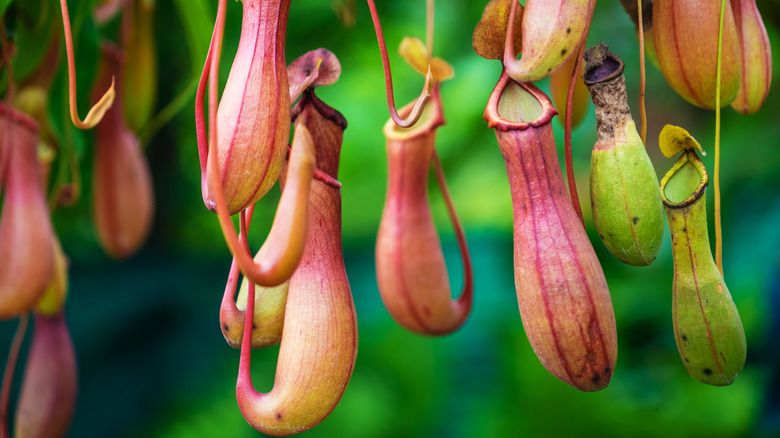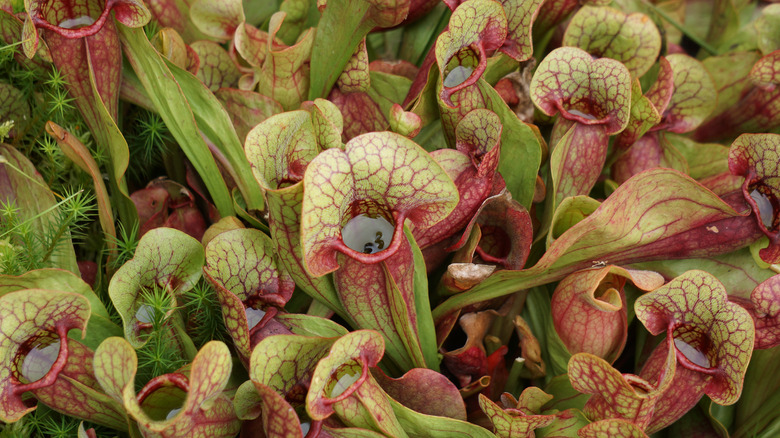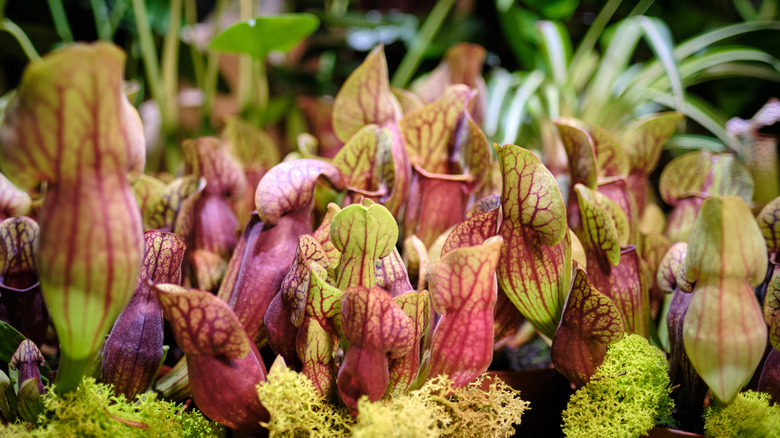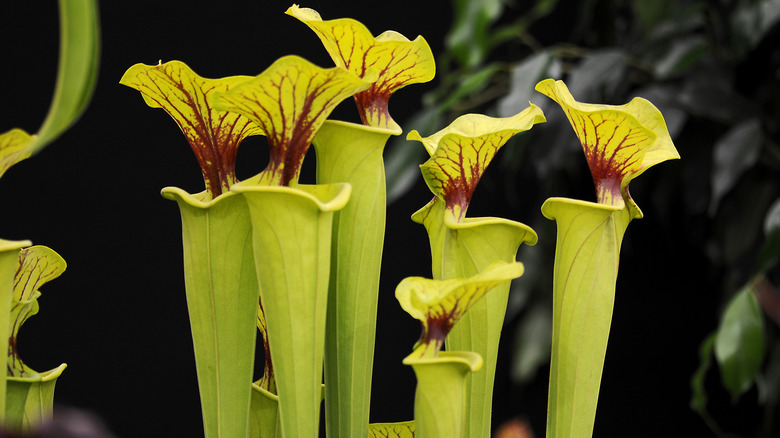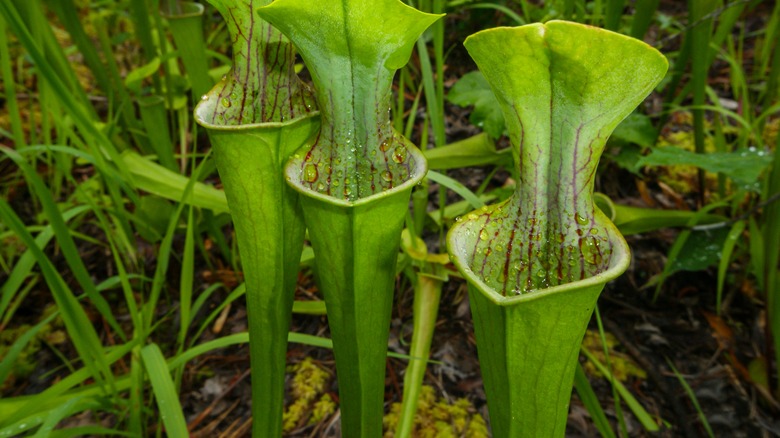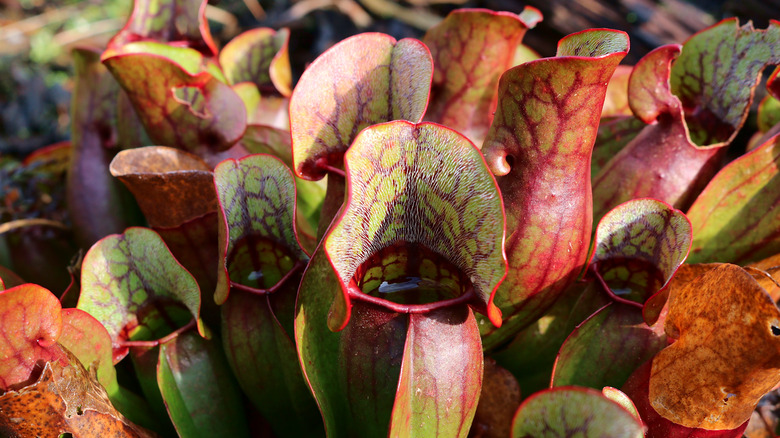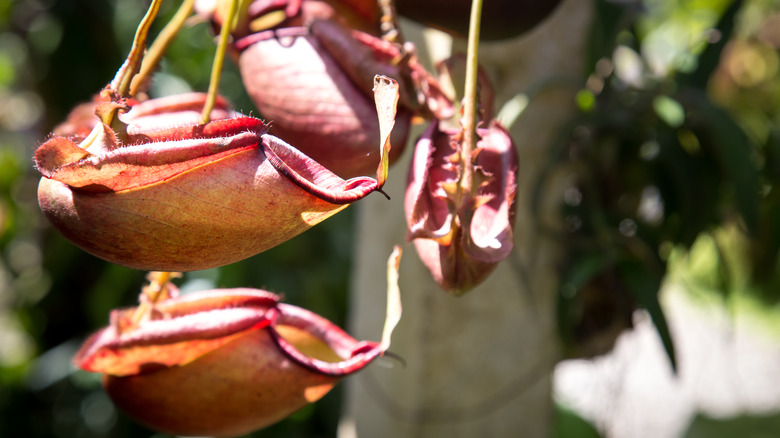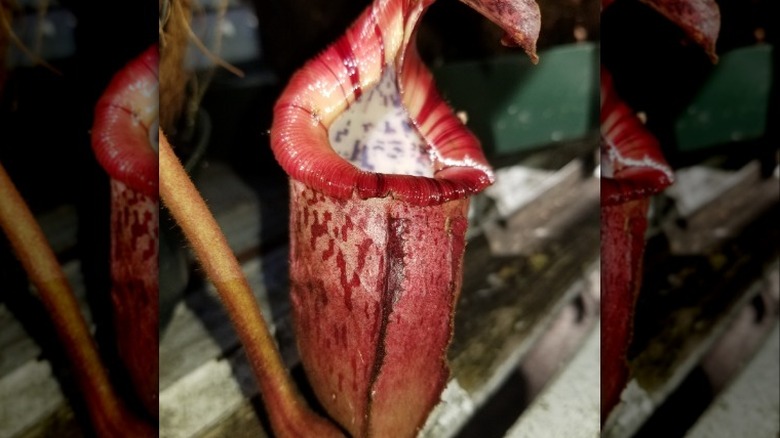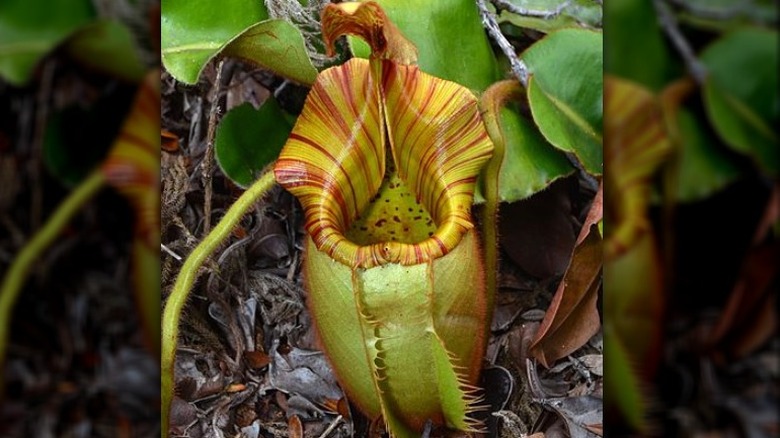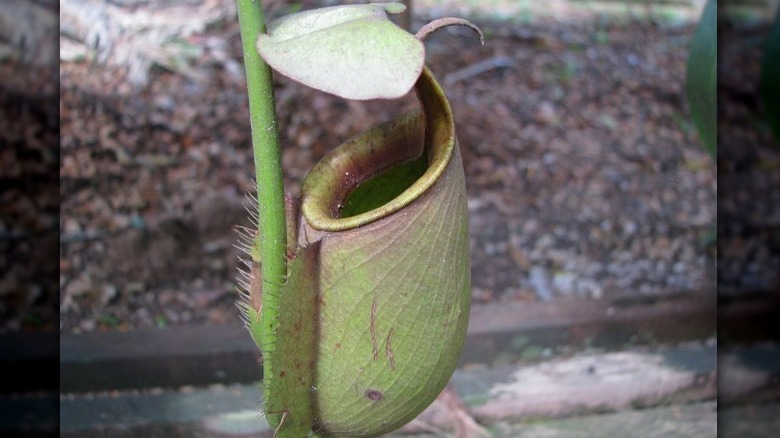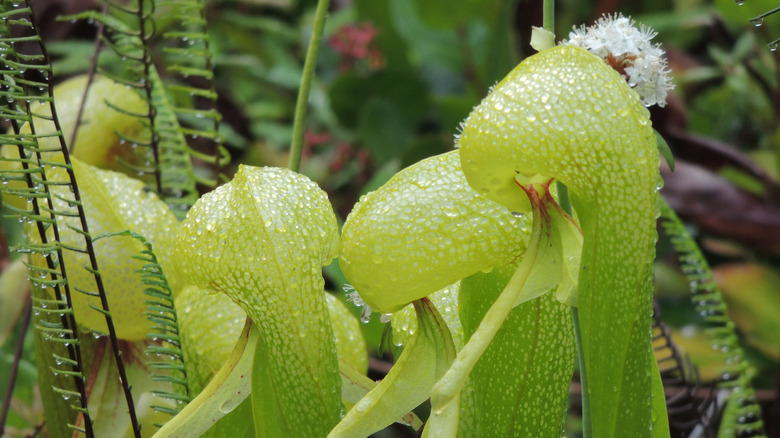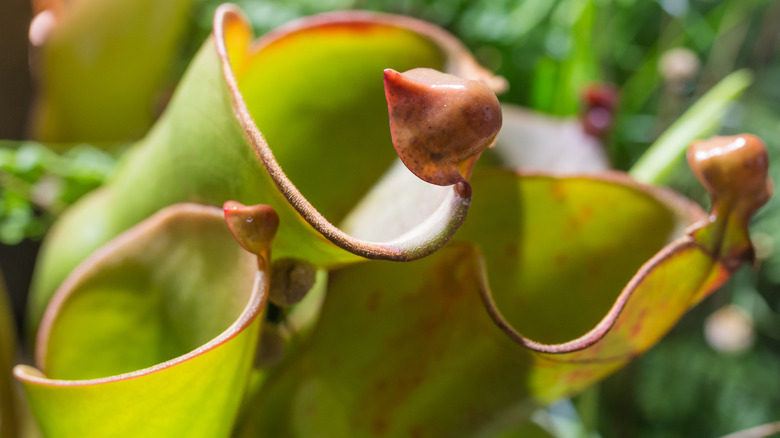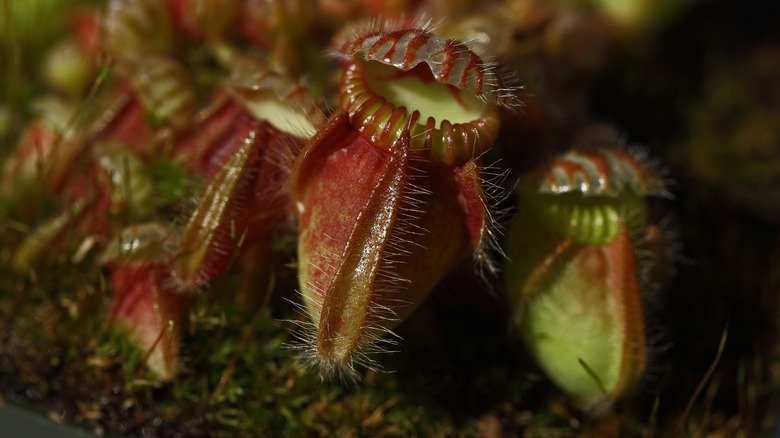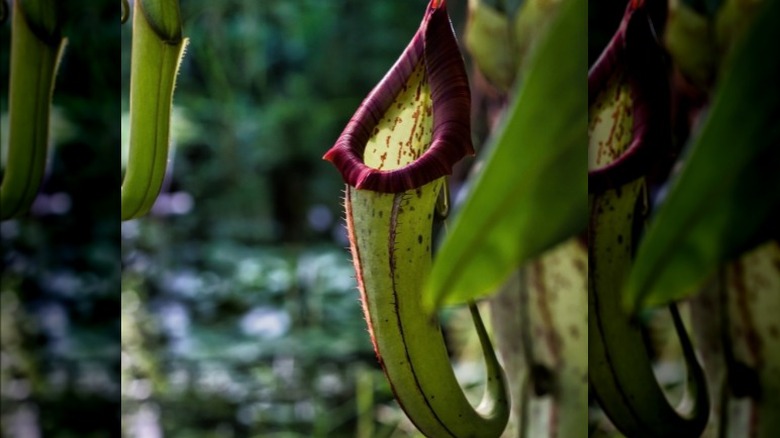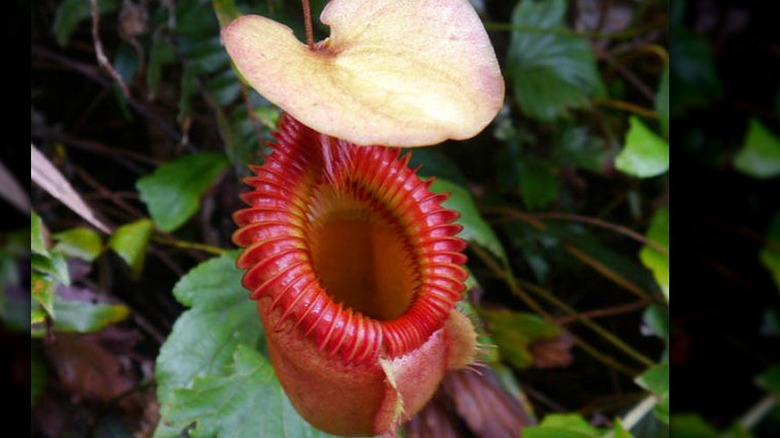15 Types Of Pitcher Plants And How You Can Take Care Of Them
Earlier on when we shared with you 30 ideas for a stunning flower garden, we told you not to be afraid of getting dramatic with flower choices. Today, we have the perfect show-stopping flower pick: Mymy DIY writes that the pitcher plant (Nepenthes) is a carnivorous plant, end of story; they are bug-eating plants. True to their name they have a pouch that looks very much like a pitcher, which contains fluid powerful enough to digest insects.
With boss predator moves, the pitcher plant attracts prey with its little flower bait and then digests it for nutrients. These plants independently acquire food because they are native to areas with poor soil, meaning that nourishment has to be derived from other sources, says Gardening Know How. We get why you would want one, and so we have curated a list of 15 pitcher plants just for you, in order to figure out which one is best suited for your garden.
1. Purple pitcher plant
With the purple pitcher plant (sarracenia purpurea), what you want to look out for is a cluster of modified cylindrical leaves that are either green, yellow, or reddish, says Royal Botanical Gardens. You expected the leaves to be purple, didn't you? Well, the aforementioned site also says the diverse colored leaves always have streaks of purple-like veins on the plant's body and hood at the lid, you know, for the snapping and trapping of prey!
Also called Adam's cup, Gardenia states that this pitcher plant will last an entire year or maybe two, with an exception being if it is damaged by cold or fire.
2. White trumpet pitcher plant
If you're looking for rather tall flowers to complement the already tall flower-dominated garden you have, we think you should check out the white trumpet pitcher plant (sarracenia leucophylla). The distinguishing visual features of this plant are white and red colored trumpet openings with a knack for attracting mostly wasps and flying insects, claims Carnivorous Plant Nursery.
This pitcher plant, Gardenia writes, produces its traps two times in a year, or season — the large plants in fall and a few small ones in spring.
3. Yellow pitcher plant
If you have a thing for erect flowers, a great fit for your garden will be the yellow pitcher plant (sarracenia flava). Not only does this plant add the required drama and difference to your garden, but it also works well for aesthetics because Wildflower Center says that this species has bright, showy yellow colors that simply cry out for attention. Additionally, the yellow pitcher plant has a musty (not mustard) odor.
NC State Extension writes that these perennial pitcher plants are excellent pollinators that grow in spring and are also sometimes red-veined.
4. Green pitcher plant
Wildflower Center says that the green pitcher plant (sarracenia oreophila) is an endangered species and so, we have no idea how you can get your hands on one. However, if you do (legally of course), they will forever grant you gardener bragging rights. These plants have flowers that come in an intense burgundy that are difficult to miss, says Slelo Prism.
What you want to do for care and maintenance is to cut off the flowers when they die and to mulch the bottoms to prevent the plant from freezing up, says Gardening Know How.
5. Parrot pitcher plant
The parrot pitcher plant (Sarracenia psittacina) seems to be naturally laid-back. By this, we mean it is a low-growing pitcher plant. When discussing its features, Carnivorous Plant Nursery says that these pitcher plants have green and red traps that are shaped like bulbs and that their prey can be caught in air or in water because of its proximity to the ground.
For care, you want to ensure that you place the plant in open, sunny, and very wet habitats if you want it to last for two years like it ought to, says the Florida Wildflower Foundation.
6. Tropical pitcher plant
California Carnivores say that pitcher plants (nepenthes) are the top dog when it comes to carnivorous plants; they literally called them royalty. Much of a brag, yes, but it may just be true. The tropical pitcher plant (nepenthes ventricosa) is a beginner-level plant because it is easy to grow — even the brown thumbers can hop on this.
Carnivorous Plant Resources writes that this plant has a rounded beer belly and it has a deep red lining at its mouth. That gives us the chills! For care, Plantinterrarium says to water from overhead and to never let the soil dry out.
7. Splendid pitcher plant
If you are in the market for some kind of classy, oriental yet dramatic plant, the splendid pitcher plant (nepenthes edwardsiana) is the plant you are looking for. Carnivorous Plant Resources writes that the splendid pitcher plant combines beastly characteristics along with a classy handsome presentation; it has flanged spikes along with a cylindrical pitcher shape and sports a lovely orange-red color. It's stunning, and also very rare, so make sure you purchase this plant from a vetted seller.
8. Villose pitcher plant
Expecting another carnivorous plant? Yes, but you were not expecting one that comes in candy stripes. Seriously, nature is phenomenal. The Villose pitcher plant ( Nepenthes Veitchii), according to Pet Fly Trap, is a hybrid clone of multiple species, as well as a toothy plant that can withstand extreme weather conditions.
For care, Bergen Water Gardens & Nursery recommends that you never let your plant soak in water, but you should always add a little bit of water into the pitcher trap.
9. Monkey cups
First, to dispel the myth, Top Tropicals categorically states that monkeys do not drink from monkey cups (Nepenthes). So, now that we have a clean slate we can get to the facts. This is an exotic-looking pitcher plant (of course you expect no less from a nepenthes) that is comprised of tendrils and globes, says Warner's Nursery.
For its care, since it takes about five to 10 years to fully mature, monkey cups require at least four hours of direct sunlight. Replace fluid with rainwater if the original ever gets spilled, writes Plantify.
10. Tropical pitcher plant
Not to be confused with the aforementioned tropical pitcher plant (nepenthes ventricosa) the nepenthes mirabilis or tropical pitcher plant is said to be the most widespread of all the tropical pitcher plants. It is also a variety that is not at all endangered; if anything, its population keeps increasing, writes IOP Publishing.
The defining characteristics of this pitcher plant are that it has shallow roots and climbing stems. It also displays a pink hue if it's grown in just the right conditions, per Pitcher Plant Farm.
11. California pitcher plant
This pitcher plant has quite the unique appearance. The California pitcher plant (darlington california) is also called the cobra lily, and according to My Plantin, this is because this pitcher plant has tube-shaped leaves that look like a cobra about to strike. If you want the full package, it also has branched leaves that can present from a greenish-purple to a yellow color that is reminiscent of the cobra fangs or a snake's tongue. You cannot miss it.
For care, Guide to Houseplants recommends that you provide this plant with humid air and moist, nutrient-deficient soil.
12. Sun pitcher plant
The sun pitcher plant (heliamphora SPP.) tries to imitate a vase and it does this so very well; you just have to take a gander to see what we mean. California Carnivores writes that these pitcher plants are beautiful, shaped like urns, and have flowers that look like long lilies.
These red, green, and deep purple pitcher plants can survive extreme weather conditions of lower than 35 degrees and higher than 90 degrees, writes Carnivorous Plant Resource – that is a wide range and we are impressed.
13. Western Australian pitcher plant
If you are one for exclusivity, you really should consider growing the western Australian pitcher plant (cephalotus follicularis) because it is the only species of the genus celophathus, writes Learn about Nature. And if you pull it off and grow a worthy western Australia pitcher plant in your garden, we see gardener excellence knocking on your door.
Hampshire Carnivorous Plants describes this one as a small, low-growing, plant with evergreen leaves that grow from rhizomes in the earth. For care, the Terrarium Planting Guide recommends growing in nutrient-free soil and rainwater.
14. Veitch pitcher plant
If you are into the unconventional, we think the Veitch pitcher plant (nepenthes veitchii) will be a lovely fit for you because according to Exotica Esoterica, it resembles the structure and appearance of gills. Creepy, but pretty cool!
Also called the epiphytic pitcher plant because of its ability to adapt to its surroundings and succeed as a climber, writes Carnivorous Plants Resources, Veitch pitcher plants do like to be at a temperature of about 70 degrees. They also prefer to be on the drier side, as explained by Tom's Carnivores.
15. Kinabalu pitcher plant
Finally, if you cannot choose because they all seem too good, you should consider growing a hybrid pitcher plant. Arts And Culture writes that the Kinabalu pitcher plant (nepenthes kinabalu) is a hybrid between the nepenthes villosa and nepenthes rajah. Additionally, this plant got its name from the fact that it was first discovered on a mountain. As for appearance, Kinabalu pitcher plants have elevated ribs and long teeth, and grow best in open, cloudy regions.
